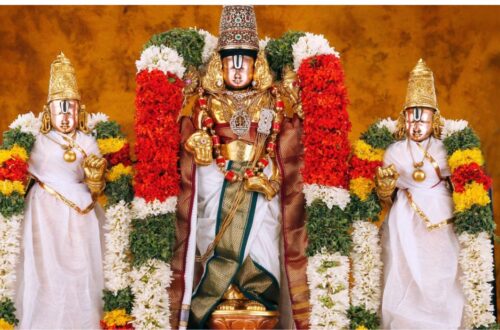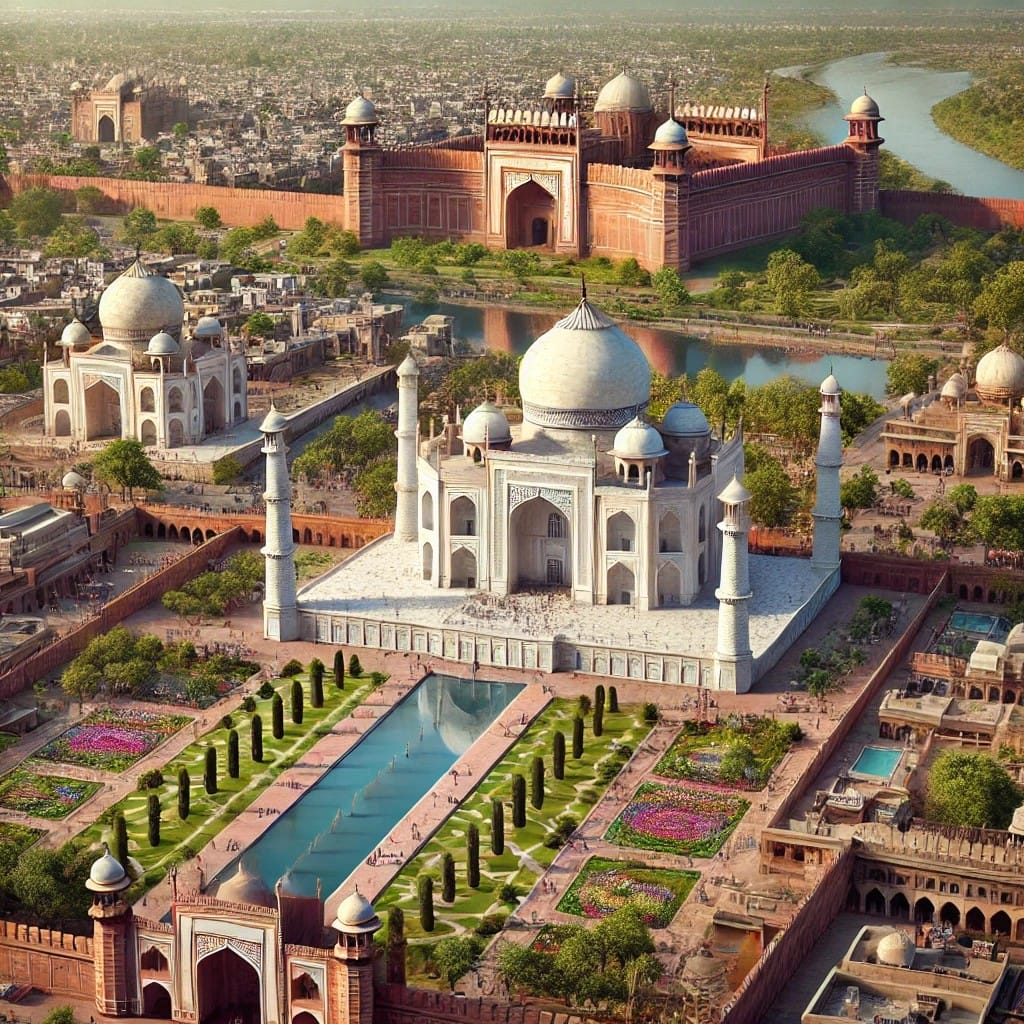
Agra: A Glimpse into the City of Love and History
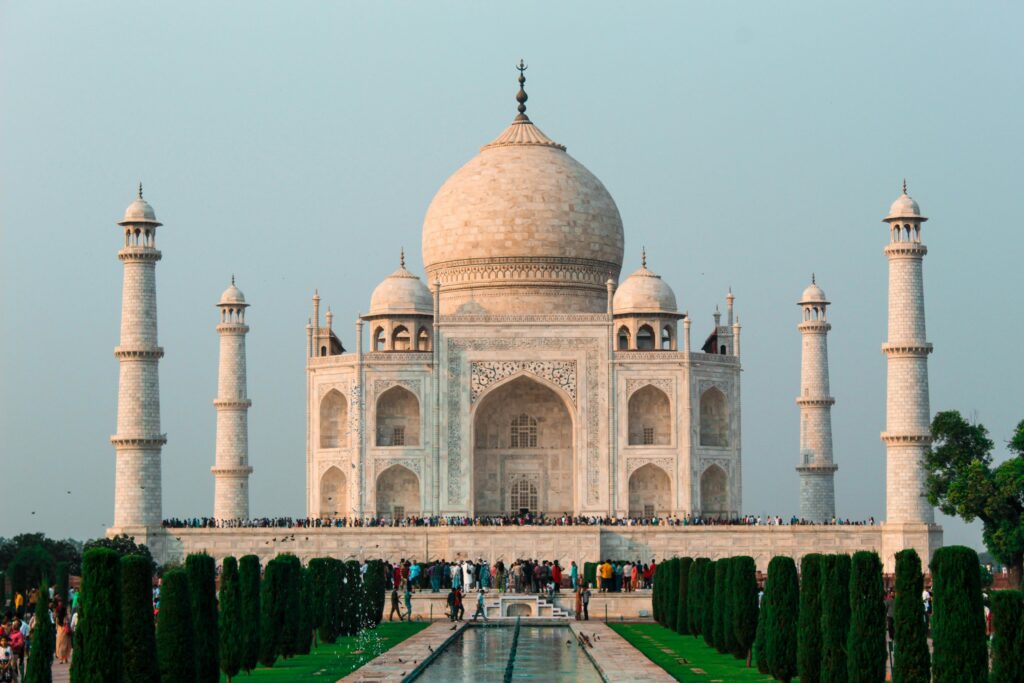
Agra, located in the northern state of Uttar Pradesh, India, is a city steeped in history and culture. It lies on the banks of the Yamuna River and is best known for housing the world-famous monument of love, the Taj Mahal Cultural heritage of Agra. The city’s rich history, which spans centuries, particularly during the Mughal era, has made it a significant cultural and architectural hub. Agra is not just about the Taj Mahal but also boasts several other historical monuments, lush gardens, and vibrant markets, making it one of the most popular tourist destinations in India.
Historical Background Cultural heritage of Agra:
Agra’s history dates back to the Mahabharata period when it was referred to as “Agravana.” However, it rose to prominence during the Mughal era, particularly in the 16th and 17th centuries. The city was founded by Sikandar Lodi of the Lodi dynasty in 1504, and later, it became the capital of the Mughal Empire under Emperor Akbar.
During the reigns of Akbar, Jahangir, and Shah Jahan, Agra developed into a centre of art, architecture, and trade. The Mughals left behind a legacy of grand monuments, including the Taj Mahal, Agra Fort, and Fatehpur Sikri, all of which are today UNESCO World Heritage Sites. Agra remained the Mughal capital until the empire shifted its base to Delhi in the 17th century.
Geographical Setting of Agra:
Agra is strategically located along the Yamuna River, approximately 200 kilometres southeast of India’s capital, New Delhi. Its geographical position has historically made it an important point for trade and military strategy during the reigns of various empires. The climate of Agra is typically North Indian, with hot summers, cool winters, and a brief monsoon season. The best time to visit Agra is between October and March when the weather is pleasant and ideal for sightseeing
Key Attractions:
1. Taj Mahal: Historical Background
The Taj Mahal, located in Agra, India, is one of the most iconic monuments in the world and a UNESCO World Heritage Site. Its history is deeply intertwined with the love story of Emperor Shah Jahan and his wife, Mumtaz Mahal.
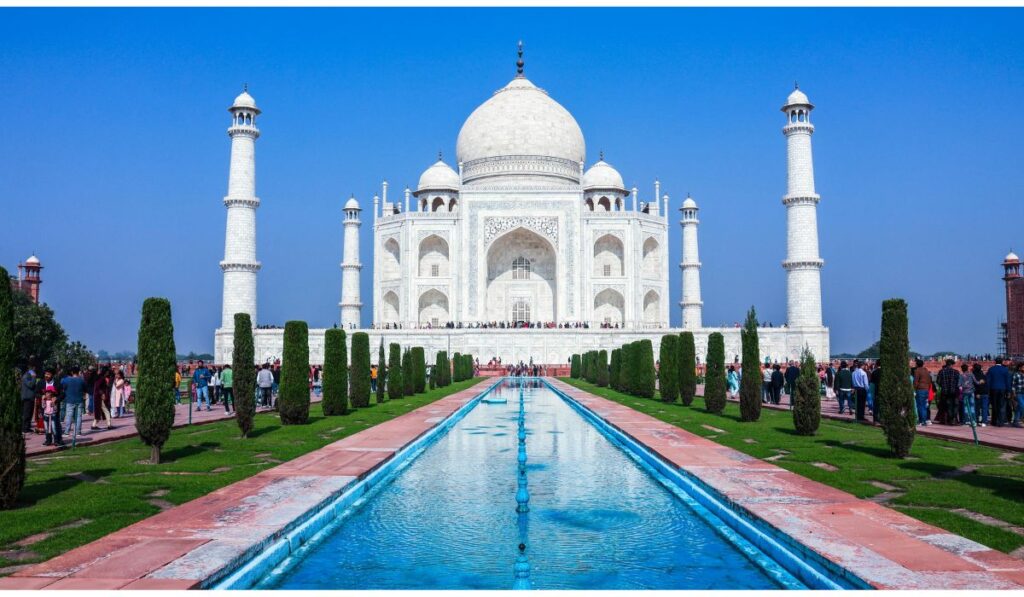
Construction and Inspiration Taj mahal, Agra
- Commissioned: The Taj Mahal was commissioned in 1632 by Shah Jahan, the fifth Mughal emperor, as a mausoleum for his beloved wife, Mumtaz Mahal, who died during childbirth. The name “Taj Mahal” translates to “Crown of the Palace.”
- Architectural Design: The monument was designed by a team of architects led by Ustad Ahmad Lahori. It represents a blend of Persian, Indian, and Islamic architectural styles, characterized by its white marble facade, intricate inlay work, and symmetrical gardens.
- Materials and Labor: The construction involved thousands of artisans, craftsmen, and laborers. The marble was sourced from Makrana in Rajasthan, while other materials came from different parts of India and even abroad. It is estimated that the project took about 22 years to complete, with its final touches finished in 1653.
Symbolism
The Taj Mahal is not just a stunning piece of architecture; it symbolizes eternal love and devotion. Shah Jahan’s grief over the loss of Mumtaz Mahal is reflected in the monument’s beauty and design, which aims to evoke feelings of peace and tranquility.
Historical Context
- Mughal Empire: The construction of the Taj Mahal occurred during the height of the Mughal Empire, a time marked by significant achievements in art, architecture, and culture. Shah Jahan’s reign is often considered the golden age of Mughal architecture, with the Taj Mahal being its most famous exemplar.
- Later History: After Shah Jahan’s death in 1666, he was laid to rest alongside Mumtaz Mahal in the Taj Mahal. Over the centuries, the monument has faced various challenges, including environmental damage and threats of neglect. However, restoration efforts have helped preserve its grandeur.
Modern Significance Taj Mahal
Today, the Taj Mahal is recognized as a symbol of India and an enduring testament to love. It attracts millions of visitors each year, making it one of the most visited monuments in the world. Its influence extends beyond architecture, inspiring art, literature, and culture globally.
The Taj Mahal continues to stand as a magnificent reminder of the Mughal legacy and the powerful emotions that inspired its creation.
2. Agra Fort:
Another UNESCO World Heritage Site, the Agra Fort is an impressive red sandstone structure built by Emperor Akbar in 1565. It served as the residence of the Mughal emperors and was a centre of governance during their reign. The fort contains a series of palaces, mosques, and gardens, and offers a stunning view of the Taj Mahal from its ramparts. Important structures within the fort include Jahangir’s Palace, the Khas Mahal, and the Diwan-i-Am.
3. Fatehpur Sikri; Agra:
Located about 40 kilometres from Agra, Fatehpur Sikri is a historic town built by Emperor Akbar in the late 16th century. It served as the Mughal capital for around 14 years before being abandoned due to a shortage of water. The city’s grand architectural design, particularly the Buland Darwaza (the largest gateway in the world) and the Jama Masjid, remains a testimony to Akbar’s vision of an ideal capital.
4. Itimad-ud-Daulah’s Tomb Agra:
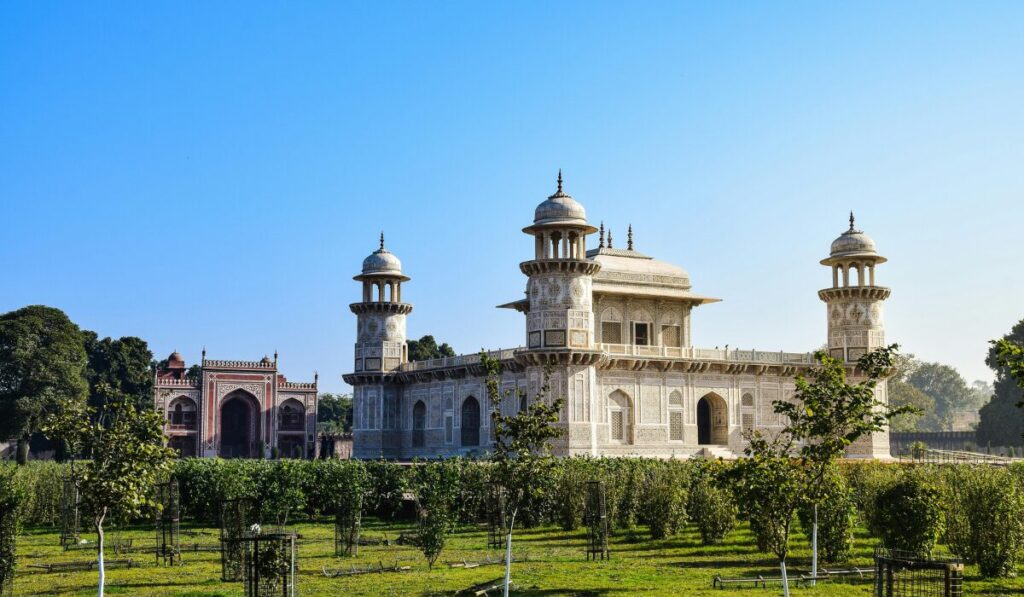
Often referred to as the “Baby Taj,” this tomb was built between 1622 and 1628 for Mirza Ghiyas Beg, the father of Nur Jahan, Emperor Jahangir’s wife. The tomb is smaller than the Taj Mahal but is considered an important precursor to it, showcasing intricate marble work and delicate designs.
5. Mehtab Bagh:
Situated opposite the Taj Mahal across the Yamuna River, Mehtab Bagh is a large, square garden that was designed to provide an uninterrupted view of the Taj Mahal. The garden is an ideal spot to watch the monument at sunset.
6. Jama Masjid: One of the largest mosques in India, the Jama Masjid in Agra was built by Shah Jahan’s daughter, Jahanara Begum, in 1648. It is known for its architectural beauty and religious significance.
Culture and Festivals Agra:
Agra’s culture is a blend of Mughal and modern influences. The city has a vibrant cultural scene, with music, dance, and arts being an integral part of its heritage. The local cuisine is famous for its Mughlai Flavors, with dishes like kebabs, biryanis, and pethas (a sweet made from ash gourd) being highly popular.
The people of Agra celebrate various festivals with great enthusiasm. Some of the most important festivals include:
Taj Mahotsav in Agra: Held annually in February, this 10-day cultural festival showcases the art, craft, music, and dance of India. It also features performances from renowned artists and craftsmen from across the country.
Ram Barat: A grand procession that celebrates the marriage of Lord Rama, part of the Ram Lila celebrations in Agra, and draws thousands of participants.
Economy:
Agra’s economy is driven primarily by tourism, given its historical significance and the presence of iconic landmarks. However, the city is also known for its leather goods, handicrafts, and marble inlay work, all of which are sold in bustling local markets. Agra has a thriving leather industry, with several small and large-scale units operating in the region.
The city’s strategic location on the Delhi-Mumbai and Delhi-Kolkata corridors also makes it an important hub for trade and commerce.
Modern Agra:
While Agra is deeply rooted in its historical and cultural heritage, it is also evolving into a modern urban centre. The city has witnessed significant infrastructure development in recent years, with better road connectivity, improved public transportation, and upgraded facilities for tourists.
However, challenges like air pollution and over-tourism remain significant issues for the city, particularly concerning the preservation of the Taj Mahal. The local government and conservation organizations are working on measures to protect the monument from environmental damage and manage the flow of visitors more sustainably.
Conclusion:
Agra is a city that beautifully merges the past with the present. Its historical significance, architectural wonders, and cultural richness make it a must-visit destination for tourists from around the world. While the Taj Mahal continues to be its crowning glory, the city’s other attractions, its vibrant culture, and its contribution to India’s heritage make Agra an enduring symbol of the country’s historical and cultural identity.



